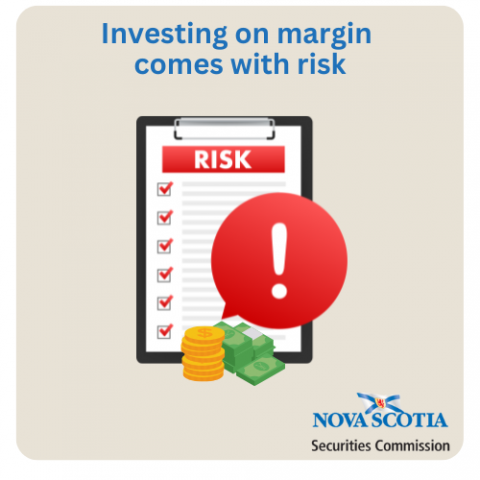Submitted by nsscadmin on

We’ve heard that a popular online broker has recently begun offering margin accounts to their customers. With margin now being available to more people, we thought it was a good idea to review the risks. Investing on margin comes with tremendous risk. While there is the opportunity for large gains while investing on margin, there is also the chance you will lose your investment and money to your investment firm.
Before we begin, remember that the Commission does not provide advice, and we’re not advising anyone to invest using a margin account. This post simply provides basic information on margin accounts to help investors make more informed decisions. If you’re thinking about investing using margin, make sure you examine the risks as part of determining if it’s right for your financial situation.
So, what is investing on margin? A margin account allows you to purchase investments with your money and money loaned to you from your broker. There are rules around how much borrowed money you can use when purchasing an investment on margin. As with any type of loan there is interest charged on the loaned money and the amount borrowed must be paid back whether the investment gains or loses value. By investing on margin, you have the chance to increase your gains, but you also increase your losses.
Here’s a basic example of how investing on margin works. You want to purchase 1000 shares in Company A which is currently trading at $100 a share. This purchase would cost you $100,000. You have $50,000 of your own cash in your account and to complete the transaction you borrow an additional $50,000 on margin. You must pay back the $50,000 plus interest to your broker.
Now let’s look at some potential outcomes to your $100,000 investment. We’re leaving the interest payments out of our examples to make it easier to understand, but don’t forget they are still being paid.
The table below shows three scenarios for our margin investment where the price increases to $200, decreases to $50 and decreases to $25.
|
Price |
200.00 |
50.00 |
25.00 |
|
Investment value |
$200,000 |
$50,000 |
$25,000 |
|
Repayment of Margin |
-$50,000 |
-$50,000 |
-$50,000 |
|
Amount after repayment of margin |
$150,000 |
$0 |
-$25,000 |
|
Investment return on Margin |
200% |
-100% |
-150% |
With an increase in price, the margin that your broker provided allowed you to enhance your returns, resulting in a 200% return on your cash investment of $50,000.
However, investment returns are not guaranteed, and the value can decrease. As the table shows, if the price decreases from the original $100 to $50, you have to repay the margin amount and as a result lose all of your original investment.
When prices drop further to $25, you are responsible for the entire loan and must somehow come up with the additional $25,000 you owe. Margin loans must be repaid no matter the performance of the investment.
Investing on margin also puts you at risk of a margin call. A margin call occurs when the value of your margin account falls below the amount owed to the broker. That’s what happened in our example above. When a margin call occurs, the investor must add more money to cover the loss or face liquidation of their entire account.
If investing on margin has become an option available to you recently ensure you fully understand all the risks before investing. Margin accounts aren’t for everyone, and the risks can sometimes be too high and derail your financial goals.
